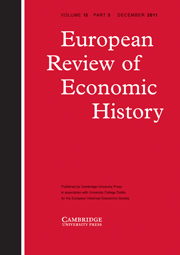Crossref Citations
This article has been cited by the following publications. This list is generated based on data provided by
Crossref.
Hale, Matthew
Hawkins, Richard
and
Wright, Catherine
2009.
List of publications on the economic and social history of Great Britain and Ireland published in 2008.
The Economic History Review,
Vol. 62,
Issue. 4,
p.
953.
Clark, Gregory
Cummins, Joseph
and
Smith, Brock
2010.
The Surprising Wealth of Pre-Industrial England.
SSRN Electronic Journal,
PRATT, DAVID
SCHOFIELD, P. R.
HEALEY, JONATHAN
KIRBY, PETER
BRADLEY, KATE
TAYLOR, JAMES
and
BROWNLOW, GRAHAM
2010.
Review of periodical literature published in 2008.
The Economic History Review,
Vol. 63,
Issue. 1,
p.
187.
Clark, Gregory
2010.
1381 and the Malthus Delusion.
SSRN Electronic Journal,
Boberg-Fazlic, Nina
Sharp, Paul Richard
and
Weisdorf, Jacob Louis
2011.
Survival of the Richest? Social Status, Fertility, and Social Mobility in England 1541-1824.
SSRN Electronic Journal,
Boberg-Fazlic, N.
Sharp, P.
and
Weisdorf, J.
2011.
Survival of the richest? Social status, fertility and social mobility in England 1541-1824.
European Review of Economic History,
Vol. 15,
Issue. 3,
p.
365.
Alfani, Guido
2012.
From Malthus’ Stagnation to Sustained Growth.
p.
18.
CLARK, GREGORY
CUMMINS, JOSEPH
and
SMITH, BROCK
2012.
Malthus, Wages, and Preindustrial Growth.
The Journal of Economic History,
Vol. 72,
Issue. 2,
p.
364.
Edvinsson, Rodney Benjamin
2013.
Swedish GDP 1620–1800: stagnation or growth?.
Cliometrica,
Vol. 7,
Issue. 1,
p.
37.
Greasley, David
Madsen, Jakob B.
and
Wohar, Mark E.
2013.
Long-run growth empirics and new challenges for unified theory.
Applied Economics,
Vol. 45,
Issue. 28,
p.
3973.
Clark, Gregory
2013.
1381 and the Malthus delusion.
Explorations in Economic History,
Vol. 50,
Issue. 1,
p.
4.
Erdkamp, Paul
2014.
How modern was the market economy of the Roman world?.
OEconomia,
p.
225.
Edvinsson, Rodney Benjamin
2015.
Recalculating Swedish pre-census demographic data: Was there acceleration in early modern population growth?.
Cliometrica,
Vol. 9,
Issue. 2,
p.
167.
Voutilainen, Miikka
2015.
Malthusian checks in pre-industrial Sweden and Finland: a comparative analysis of the demographic regimes.
Scandinavian Economic History Review,
Vol. 63,
Issue. 3,
p.
235.
Erdkamp, Paul
2016.
Economic growth in the Roman Mediterranean world: An early good-bye to Malthus?.
Explorations in Economic History,
Vol. 60,
Issue. ,
p.
1.
Abildgren, Kim
2017.
Trends in real wages in Denmark since the Late Middle Ages.
Historical Methods: A Journal of Quantitative and Interdisciplinary History,
Vol. 50,
Issue. 2,
p.
67.
Edvinsson, Rodney Benjamin
2017.
The response of vital rates to harvest fluctuations in pre-industrial Sweden.
Cliometrica,
Vol. 11,
Issue. 2,
p.
245.
Federico, Giovanni
and
Sharp, Paul
2017.
Karl Gunnar Persson (1943–2016).
European Review of Economic History,
Algaze, Guillermo
2018.
Entropic Cities: The Paradox of Urbanism in Ancient Mesopotamia.
Current Anthropology,
Vol. 59,
Issue. 1,
p.
23.
Madsen, Jakob B.
Robertson, Peter E.
and
Ye, Longfeng
2019.
Malthus was right: Explaining a millennium of stagnation.
European Economic Review,
Vol. 118,
Issue. ,
p.
51.


